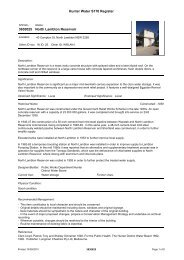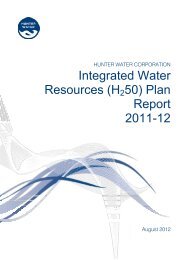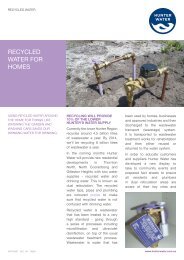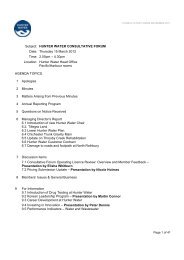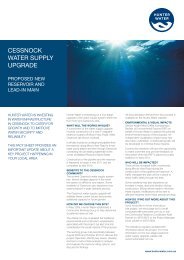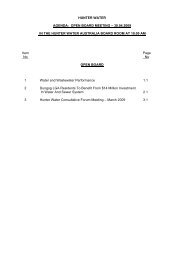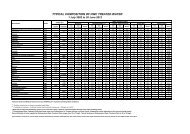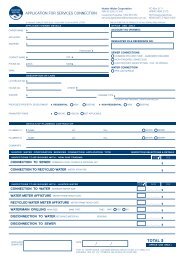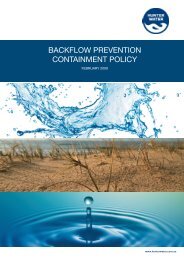Catchment Management Plan - Hunter Water
Catchment Management Plan - Hunter Water
Catchment Management Plan - Hunter Water
You also want an ePaper? Increase the reach of your titles
YUMPU automatically turns print PDFs into web optimized ePapers that Google loves.
3.1 Element 1: Identify thetop hazardsPurposeTo provide a robust,repeatable and consistentassessment of hazards based onland management practices so thatrectification efforts are addressed inpriority order and are cost effective.PrécisThere is a large diversity of potentialrisks to water quality in catchments.How should septic overflow in theWilliams catchment be ranked againstthe presence of cattle in the river in theChichester catchment? A repeatableand transparent way of assessingthese scenarios is required. <strong>Hunter</strong><strong>Water</strong> is working in close collaborationwith the Sydney <strong>Catchment</strong>Authority to develop a Source <strong>Water</strong>Improvement Support System (SWISS)model for our catchments.3.1.1 Previous hazard rankingin catchmentsIn the Operational Audit 2008/2009Report to the Minister, IPART recognisedthe improvements made to <strong>Hunter</strong><strong>Water</strong>’s catchment performance andreporting. IPART specifically referenced<strong>Hunter</strong> <strong>Water</strong>’s completion of a waterquality risk assessment to identify,assess and address (if necessary) thelargest risks to water quality from the‘catchment to the tap’. The processfollowed the framework that is set downin the Guidelines; firstly an expert panelof <strong>Hunter</strong> <strong>Water</strong> staff was convened, thenrisks were identified and finally rankedusing <strong>Hunter</strong> <strong>Water</strong>’s corporate risk ratingtables. The expert panel then eitheraccepted that the risk was controlledadequately or provided comment on howthe risk should be reduced.When addressing catchment risks,the panel determined that two of thelargest risks to water quality were fromincreasing urbanisation in catchmentsand some farming practices. Table 1summarises the risk assessment findings.The expert panel did not accept that thecurrent risk to water quality in catchmentswas adequately controlled but recognisedthat these risks could not be controlledusing a single engineered approach.A more comprehensive catchmentmanagement plan was required.3.1.2 A new system forranking catchment risksAround Australia, water authorities andcatchment management bodies employa diversity of methods to identify andrank catchment risks. Most authoritiesview the identification of the level ofrisk and the location of these problemsas the foundation data upon which tobuild a catchment management plan.<strong>Hunter</strong> <strong>Water</strong> and a consultant separatelyreviewed the methods for determiningcatchment risks throughout Australia andconcluded that many authorities weremoving towards semi-quantitative modelsto identify risk and direct catchmenteffort. Some of the tools for catchmentmanagement reviewed included:• The e<strong>Water</strong> <strong>Catchment</strong>Modelling Toolkit,• The University of WesternAustralia’s storage and aquaticsystems models,• The Restoration Prioritisation Tool(RPT) used by some <strong>Catchment</strong><strong>Management</strong> Authorities• The Sydney <strong>Catchment</strong> Authority’sSource <strong>Water</strong> Improvement SupportSystem (SWISS)<strong>Hunter</strong> <strong>Water</strong> chose to pursueimplementation of the SCA SWISSbecause:1. SCA has a strong track record incatchment management planningwhich includes development andimplementation of the Source <strong>Water</strong>Improvement Support System(SWISS) for prioritisation of works.This model provides the rationalefor catchment expenditure in excessof $21 million per year;2. The system is currently embedded inSCA’s catchment management policy,demonstrating its functionality;RIsk potential threat potential scenario Consequence Likelihood Inherent 3Risk LevelIncreasingIncreased number • Pathogens/toxins inExtreme C (1 in 5 years) very highurbanisation(including sewerof pathogens 1 andchemical pollutants 2 catchments bypass treatmentprocess and enter the <strong>Hunter</strong>’soverflow anddrinking water.increased stormwaterdischarge)• Increased algal productivity andresults in taste and odour ortoxic compounds produced.Some farmingpractices(e.g. cattle in rivers)Increased pathogens 1and chemicalpollutants 2 and erosionfrom clearingTable 2: Inherent risk levels to <strong>Hunter</strong> <strong>Water</strong>’s drinking water quality from unmanaged catchments(summarised from <strong>Hunter</strong> <strong>Water</strong> Risk Assessment 2009)1 including Cryptosporidium, Giardia, faecal indicator organisms and associated pathogenic bacteria and viruses2 including nitrogen, phosphorus, organics, heavy metal, pesticides3 inherent risk is defined as risk that remains when current control measures are in placeCATCHMENT MANAGEMENT PLAN . ssS . 001 . JUNE2010• Pathogens/toxins in catchmentsbypass treatment process andenter the <strong>Hunter</strong>’s drinking water.• Decrease in quality and clarityof water supplied to reservoirs.Increased turbidity may makewater more difficult to treat forpathogens.Extreme C (1 in 5 years) very high24




